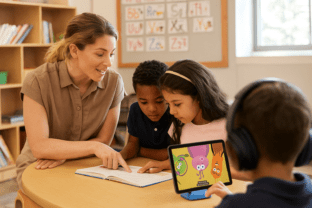Creative and critical thinking are rapidly becoming two of the most important skills a student can acquire in the digital age.
A recent study found that these 21st century skills improve “analysis, evaluation, comparison, and innovation, autonomy, and control abilities,” positively impacting students’ mental health and wellbeing.
Creative and critical thinking are in high demand by today’s employers, with 93% of business and nonprofit leaders reporting that evidence of solid critical thinking skills carries more weight than a job candidate’s undergraduate major. A survey of leaders from private and public sectors found that creativity is viewed as the “single most important leadership competency for enterprises seeking a path through… complexity.”
Breakthroughs in pedagogy and classroom technology have made creative and critical thinking more accessible than ever before, and school districts are consequently taking measures to meaningfully incorporate inquiry-based lessons and creative projects throughout their curriculum to nurture these skills.
If your district is taking steps toward meaningfully transforming the school day with higher order thinking, you’re bound to face some setbacks. As you build a culture of creative and critical thinking, save your district some time by avoiding these common mistakes.
1. Overlooking core instruction
Opportunities for creative and critical thinking should extend far beyond Genius Hour or the twenty minutes of student-led skill practice your teachers might set aside each day. If students are to truly develop these 21st century skills, creativity and critical thinking must be fully integrated into core instruction across all academic domains. As you evaluate your core curriculum, consider the model in place at Mineola Middle School and structure your units of study around interdisciplinary inquiry-based projects.

2. Ignoring community context
Creative and critical thinking don’t exist in a vacuum. Align your district’s units of study to the resources, issues, and opportunities found in your community. Ask local leaders to provide feedback on creative work, and encourage students to look to the world around them for unexpected solutions to the challenges they face in school. To prepare students to successfully navigate the uncertainties of tomorrow, teach them to apply what they learn to the world outside their classroom.
3. Failing to set boundaries
When anything goes, students are unlikely to produce their strongest work. Encourage teachers to embrace rubrics, writing prompts, and other sources of structure that give students the purpose and direction needed to spark their imagination. By modeling diverse examples of success and providing students with opportunities to flex their choice and voice, teachers can keep lessons dynamic and creative, even when providing students with helpful boundaries.

4. Using only one indicator of success
Standardized assessments aren’t the only way to measure student growth, and other indicators of growth can easily fall by the wayside if you place too much emphasis on end of year test scores. Even the most visionary districts can make the mistake of over investing in one metric of success, and educational researcher Michael Fullan says, “In most of the schools and education systems we have observed, the only student learning outcome measures available for accountability purposes are measures of curricular content mastery.” To prioritize creative and critical thinking in your district, consider using digital portfolios and formative project-based assessments to track and measure student progress towards developing these skills.
5. Forgetting the other 2Cs
To be great critical and creative thinkers, students must also master collaboration and communication skills. Instructional models that celebrate peer feedback and revision go a long way toward preparing students for what’s to come in college and careers. As an added bonus, students are more motivated to do their best work when they know what they build will be shared with audience outside of their teacher.

6. Trying to replace teachers with technology
While hundreds of online platforms promise to improve student-led skill practice, few digital tools successfully tackle the challenges of teacher-led lessons. Technology is essential to developing 21st century skills, but look for tools designed to elevate, rather than replace, the teacher. The best classroom technology for this purpose will empower teachers to customize and level the lessons they teach and projects they assign to better support the academic needs and instructional goals of their classroom.
Programs like eSpark offer powerful tools teachers can use for enhanced instruction. From direct instruction and practice through thousands of engaging activities to in-depth progress monitoring, teachers are enabled to personalize education at a higher level.
7. Failing to establish a culture of growth mindset
Before any meaningful change is to take place, district leaders must first build a culture of growth mindset. Students and teachers will be more open to taking purposeful risks in the classroom if they’re able to approach each setback as an opportunity to learn and grow. Providing teachers with adequate training and access to the research behind the new tools or pedagogy they’ll be asked to implement is an essential step in obtaining buy-in for any new initiative.


